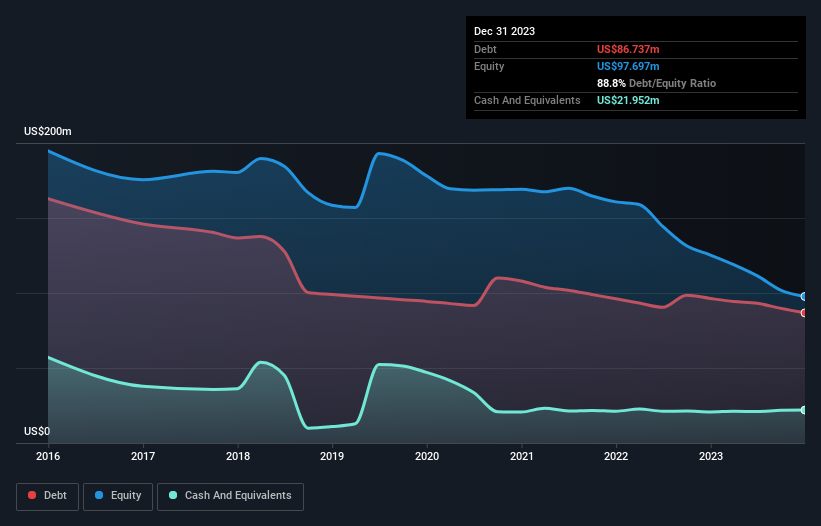Howard Marks put it nicely when he said that, rather than worrying about share price volatility, 'The possibility of permanent loss is the risk I worry about... and every practical investor I know worries about.' So it might be obvious that you need to consider debt, when you think about how risky any given stock is, because too much debt can sink a company. As with many other companies HLS Therapeutics Inc. (TSE:HLS) makes use of debt. But the real question is whether this debt is making the company risky.
What Risk Does Debt Bring?
Generally speaking, debt only becomes a real problem when a company can't easily pay it off, either by raising capital or with its own cash flow. In the worst case scenario, a company can go bankrupt if it cannot pay its creditors. However, a more usual (but still expensive) situation is where a company must dilute shareholders at a cheap share price simply to get debt under control. By replacing dilution, though, debt can be an extremely good tool for businesses that need capital to invest in growth at high rates of return. When we examine debt levels, we first consider both cash and debt levels, together.
View our latest analysis for HLS Therapeutics
How Much Debt Does HLS Therapeutics Carry?
You can click the graphic below for the historical numbers, but it shows that HLS Therapeutics had US$86.7m of debt in December 2023, down from US$96.3m, one year before. However, it also had US$22.0m in cash, and so its net debt is US$64.8m.

A Look At HLS Therapeutics' Liabilities
According to the last reported balance sheet, HLS Therapeutics had liabilities of US$26.7m due within 12 months, and liabilities of US$84.7m due beyond 12 months. Offsetting these obligations, it had cash of US$22.0m as well as receivables valued at US$10.7m due within 12 months. So it has liabilities totalling US$78.7m more than its cash and near-term receivables, combined.
This deficit is considerable relative to its market capitalization of US$101.0m, so it does suggest shareholders should keep an eye on HLS Therapeutics' use of debt. Should its lenders demand that it shore up the balance sheet, shareholders would likely face severe dilution. The balance sheet is clearly the area to focus on when you are analysing debt. But ultimately the future profitability of the business will decide if HLS Therapeutics can strengthen its balance sheet over time. So if you want to see what the professionals think, you might find this free report on analyst profit forecasts to be interesting.
In the last year HLS Therapeutics wasn't profitable at an EBIT level, but managed to grow its revenue by 2.6%, to US$63m. We usually like to see faster growth from unprofitable companies, but each to their own.
Caveat Emptor
Importantly, HLS Therapeutics had an earnings before interest and tax (EBIT) loss over the last year. Its EBIT loss was a whopping US$10m. Considering that alongside the liabilities mentioned above does not give us much confidence that company should be using so much debt. So we think its balance sheet is a little strained, though not beyond repair. For example, we would not want to see a repeat of last year's loss of US$28m. In the meantime, we consider the stock very risky. The balance sheet is clearly the area to focus on when you are analysing debt. However, not all investment risk resides within the balance sheet - far from it. For example - HLS Therapeutics has 1 warning sign we think you should be aware of.
When all is said and done, sometimes its easier to focus on companies that don't even need debt. Readers can access a list of growth stocks with zero net debt 100% free, right now.
Valuation is complex, but we're here to simplify it.
Discover if HLS Therapeutics might be undervalued or overvalued with our detailed analysis, featuring fair value estimates, potential risks, dividends, insider trades, and its financial condition.
Access Free AnalysisHave feedback on this article? Concerned about the content? Get in touch with us directly. Alternatively, email editorial-team (at) simplywallst.com.
This article by Simply Wall St is general in nature. We provide commentary based on historical data and analyst forecasts only using an unbiased methodology and our articles are not intended to be financial advice. It does not constitute a recommendation to buy or sell any stock, and does not take account of your objectives, or your financial situation. We aim to bring you long-term focused analysis driven by fundamental data. Note that our analysis may not factor in the latest price-sensitive company announcements or qualitative material. Simply Wall St has no position in any stocks mentioned.
About TSX:HLS
HLS Therapeutics
A specialty pharmaceutical company, acquires and commercializes pharmaceutical products for the treatment of psychiatric disorders, central nervous system, and cardiovascular disease in Canada, the United States, and internationally.
Reasonable growth potential with mediocre balance sheet.
Similar Companies
Market Insights
Community Narratives



